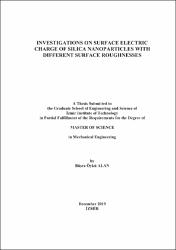Please use this identifier to cite or link to this item:
https://hdl.handle.net/11147/9654Full metadata record
| DC Field | Value | Language |
|---|---|---|
| dc.contributor.advisor | Barışık, Murat | - |
| dc.contributor.author | Alan, Büşra Öykü | - |
| dc.date.accessioned | 2020-09-04T12:23:40Z | |
| dc.date.available | 2020-09-04T12:23:40Z | |
| dc.date.issued | 2019-12 | - |
| dc.identifier.citation | Alan, B. Ö. (2019). Investigations on surface electric charge of silica nanoparticles with different surface roughnesses. Unpublished master's thesis, İzmir Institute of Technology, İzmir, Turkey | en_US |
| dc.identifier.uri | https://hdl.handle.net/11147/9654 | - |
| dc.description | Thesis (Master)--Izmir Institute of Technology, Mechanical Engineering, Izmir, 2019 | en_US |
| dc.description | Includes bibliographical references (leaves: 58-65) | en_US |
| dc.description | Text in English; Abstract: Turkish and English | en_US |
| dc.description.abstract | Silica nanoparticles have been receiving more attention from diverse research areas recently due to their significant physical properties such as large pore volume and high internal surface area, colloidal stability, high biocompatibility, and tunable pore sizes. These silica nanoparticles are great candidates for drug delivery applications because they can transport a large amount of drugs into selective organs and tissues due to their high surface area and large pore volume. However, there are important drug delivery mechanisms that need to be understood properly such as cellular uptake, endosomal escape, drug loading and release, and crossing physical barriers. Physicochemical properties of nanoparticles (size, shape, surface charge, or surface chemistry) are important for understanding these mechanisms in order to develop successful drug delivery applications. This research investigates how these surface charge properties change with different particle, pore diameters, roughness structure on the nanoparticle surface, and different temperature and solution conditions. Also, we investigate how the surface charging behavior of rough nanoparticles interacts with a flat plate. Rough nanoparticles and their interactions with surfaces theoretical assumptions can be wrong and ionic distribution can show variation locally. In order to calculate ionic distribution and surface charge properties in these systems, proper equations and boundary conditions were employed. The charge regulation model was used as a boundary condition because of the electric double layer overlap effect. Results showed that there was a considerable variation on surface charge properties due to the roughness structure with different roughness and particle sizes and temperature difference. | en_US |
| dc.description.abstract | Silika nanopartiküller yüksek iç yüzey alanı ve geniş gözenek hacmi, yüksek biyouyumluluk ve kolloidal kararlılık gibi avantajlı fiziksel özellikleri ile çeşitli biyomedikal uygulamalar için uygun adaylardır. Özellikle ilaç iletimi uygulamalarında yüksek ilaç taşıma kapasitesi sayesinde sıklıkla tercih edilirler. Silika nanopartiküllerin yüzey elektrik şarjı bu uygulamaların verimliliği açısından çok belirleyicidir. Çünkü ilaç iletimi uygulamaları sırasında görülen bazı hüçre içi mekanizmalar nanopartikülün yüzey elektrik şarjına bağlıdır. Örnek olarak, ilaç iletiminin başarısını fazlasıyla etkileyen hücresel alım mekanizması nanopartikülün yüzey elektrik şarjı ve boyutları ile doğrudan ilişkilidir. Ayrıca ilaç iletimi sırasında görülen en önemli sorunlardan birisi de endozomal kaçışın sağlanmasıdır. Nanopartikül yüzey elektrik şarjı ve boyutunun endozomal kaçışın sağlanmasında etkili olduğunu gösteren çalışmalar vardır. Bu nedenle yüzeyi pürüzlü nanoparçacıkların yüzey elektrik şarjının incelenmesi önemli bir konu oluşturmaktadır. Bu çalışmada yüzeyi gözenekli nanopartiküllerin farklı pürüz ve parçacık çapları, farklı solüsyon özellikleri, sıcaklık değişimi ve düz bir yüzey ile etkileşimi sonucunda oluşan yüzey elektrik şarjı davranışı incelenmiştir. Yüzeyi pürüzlü nanopartiküllerin yüzeyinde oluşan iyonik dağılım ve elektrik şarjı davranışının doğru olarak hesaplanabilmesi için uygun denklemler ve sınır şartları seçilmiştir. Elektriksel çift tabakaların çakışması etkisinden dolayı sınır koşulu olarak kullanılan yük regülasyon modeli nanopartikül yüzeyinde sınır şartı olarak seçilmiştir. Sonuçlar, farklı pürüzlülük ve parçacık ebatları ve sıcaklık farkına sahip pürüzlülük yapısı nedeniyle yüzey yükü özelliklerinde önemli bir değişiklik olduğunu göstermektedir. | en_US |
| dc.description.sponsorship | TUBITAK (118M710) | en_US |
| dc.format.extent | xi, 65 leaves | - |
| dc.language.iso | en | en_US |
| dc.publisher | Izmir Institute of Technology | en_US |
| dc.rights | info:eu-repo/semantics/openAccess | en_US |
| dc.subject | Surface roughness | en_US |
| dc.subject | Surface charge density | en_US |
| dc.subject | Electrical surface potential | en_US |
| dc.subject | Silica nanoparticles | en_US |
| dc.subject | Charge regulation | en_US |
| dc.subject | Nanoparticles | en_US |
| dc.title | Investigations on Surface Electric Charge of Silica Nanoparticles With Different Surface Roughnesses | en_US |
| dc.title.alternative | Farklı Yüzey Pürüzlülüklerine Sahip Silika Nanopartiküllerin Yüzey Elektrik Yükü Üzerine Araştırmalar | en_US |
| dc.type | Master Thesis | en_US |
| dc.institutionauthor | Alan, Büşra Öykü | - |
| dc.department | Thesis (Master)--İzmir Institute of Technology, Mechanical Engineering | en_US |
| dc.relation.tubitak | info:eu-repo/grantAgreement/TUBITAK/MAG/118M710 | - |
| dc.relation.publicationcategory | Tez | en_US |
| dc.identifier.wosquality | N/A | - |
| dc.identifier.scopusquality | N/A | - |
| item.openairecristype | http://purl.org/coar/resource_type/c_18cf | - |
| item.languageiso639-1 | en | - |
| item.openairetype | Master Thesis | - |
| item.grantfulltext | open | - |
| item.fulltext | With Fulltext | - |
| item.cerifentitytype | Publications | - |
| Appears in Collections: | Master Degree / Yüksek Lisans Tezleri | |
Files in This Item:
| File | Description | Size | Format | |
|---|---|---|---|---|
| 10155266.pdf | MasterThesis | 6.23 MB | Adobe PDF |  View/Open |
CORE Recommender
Page view(s)
358
checked on Mar 31, 2025
Download(s)
190
checked on Mar 31, 2025
Google ScholarTM
Check
Items in GCRIS Repository are protected by copyright, with all rights reserved, unless otherwise indicated.